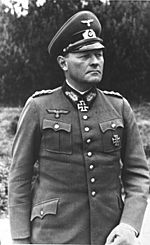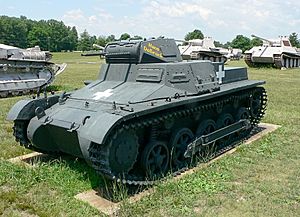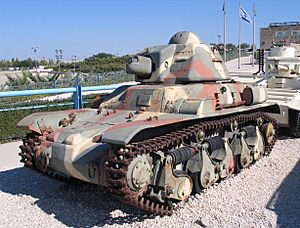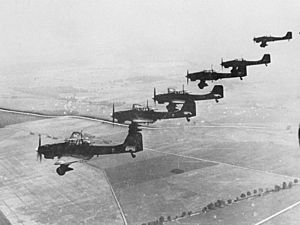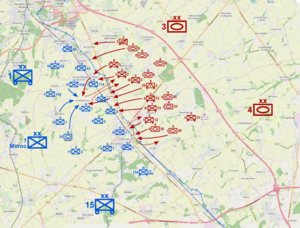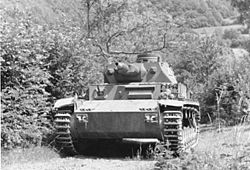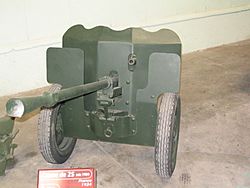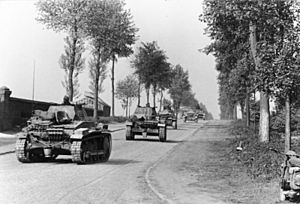Battle of Gembloux (1940) facts for kids
Quick facts for kids Battle of Gembloux |
|||||||
|---|---|---|---|---|---|---|---|
| Part of the Battle of Belgium, Western Front of World War II | |||||||
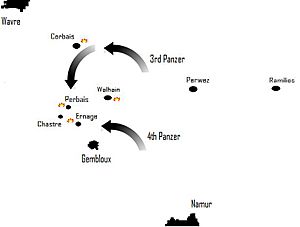 The Gembloux Gap. The Belgian central plain between Namur and Wavre was occupied by the French Corps de Cavalerie (Général René Prioux), to prevent a German breakthrough into France. |
|||||||
|
|||||||
| Belligerents | |||||||
| Commanders and leaders | |||||||
| Strength | |||||||
| 3 motorised divisions 3 infantry divisions |
2 panzer divisions 3 infantry divisions |
||||||
| Casualties and losses | |||||||
| 2,000 killed, wounded & missing III Corps: few hundred casualties |
33–37 percent of German tank strength lost 4th Panzer on 15 May: 1,000+ killed, wounded, or missing IV Corps: few hundred casualties. |
||||||
The Battle of Gembloux was a big fight between French and German armies in May 1940. This happened during World War II. On May 10, 1940, Germany's army, the Wehrmacht, invaded Luxembourg, The Netherlands, and Belgium. This attack was part of their plan called Fall Gelb (Case Yellow).
The Allied armies, including France, thought this attack in Belgium was the main German push. They sent their best and fastest troops to stop the Germans there. But the Germans had a secret plan, the Manstein Plan. They attacked through the Ardennes forest to reach the English Channel. This move aimed to trap the Allied forces in Belgium.
The French army didn't know the attack in Belgium was a trick. They planned to stop the Germans at two places: Hannut and Gembloux. The French First Army was the strongest Allied force. Its job was to defend the area between Gembloux and Wavre. The French Corps de Cavalerie went to Hannut first. Their goal was to slow down the Germans. This would give the First Army time to get ready at Gembloux.
After the Battle of Hannut, the French troops moved back to Gembloux. This was their main defense line in Belgium. For two days, the French fought off attacks from the German 6th Army. But then, the Germans broke through at Sedan, further south. This forced the French First Army to leave Gembloux and retreat towards Lille in France.
This retreat messed up the Allied defenses in central Belgium. The German armies then took over the area. The battle itself didn't decide the war. But it did keep the French First Army busy at Gembloux. This allowed the Germans to achieve their main goal of Fall Gelb by cutting off Allied forces. However, the French First Army survived. Later, during the Siege of Lille, it kept German forces busy. This helped the British Expeditionary Force and many French soldiers escape at Dunkirk.
Contents
Understanding the Battle: The Gembloux Gap
What was the Gembloux Gap?
The Gembloux Gap was a wide, open plain in central Belgium. It was a natural path for armies moving between industrial areas in France and Germany. This area had few natural obstacles like rivers or mountains. A ridge near Gembloux divided the land, but it didn't stop tanks. This made the Gembloux Gap a very important place to defend.
Military Strategies: How Armies Fought
German Battle Plans: Blitzkrieg
The German way of fighting is often called "Blitzkrieg" (Lightning War). This idea means using fast, powerful attacks with tanks and planes. The goal is to break through enemy lines quickly. This causes the enemy's army to collapse before they can react.
In 1940, Germany used tanks, aircraft, and motorized infantry (soldiers who ride in vehicles). This allowed them to move much faster than armies in World War I. Radios also helped them communicate quickly during battles.
Some historians say "Blitzkrieg" wasn't a planned strategy. They believe Germany was preparing for a longer war. But when war started, they tried to win quickly with fast attacks. This was because their economy wasn't fully ready for a long war. After France was defeated in 1940, Germany started to use this "lightning war" style more on purpose.
French Battle Plans: Careful Defense
French military ideas came from their experiences in World War I. France had lost many soldiers and faced a smaller population and industry than Germany. So, their plan was to fight carefully to save lives. They focused on "defense in depth." This meant setting up several layers of defenses.
French plans relied heavily on artillery (big guns). These guns would support infantry (foot soldiers) and tanks. They also had strong anti-tank defenses to stop enemy tanks. Soldiers were spread out in strong positions that could defend from all sides. These positions covered each other with crossfire.
The French also had tanks to support their infantry. For example, the Renault R35 tank was slow and had a small gun. But it had strong armor for its time. French divisions also had anti-aircraft guns to shoot down enemy planes.
French soldiers had high morale. They trusted their equipment and their leaders. The Moroccan and North African units in the French army were especially skilled. They were considered elite forces.
Getting Ready for Battle
German Attack Plans: Fall Gelb
The German plan, Fall Gelb, sent the 6th Army into Belgium. Their goal was to attack Gembloux with tanks and motorized troops. This would keep Allied forces busy while the main German attack went through the Ardennes. The German commander, General Walter von Reichenau, expected Allied troops to arrive quickly. He chose to attack between Wavre and Namur, where defenses seemed weakest. The German air force, the Luftwaffe, was supposed to bomb Allied troops as they moved into Belgium.
Allied Defense Plans: The Dyle Plan
The French leaders were sure Germany would make its main attack in Belgium. So, they planned to stop it with the First Army, the British Expeditionary Force (BEF), and the Seventh Army. These armies had most of the Allied tanks and motorized troops. The Dyle Plan was designed to move Allied forces into Belgium to meet the German attack.
General Blanchard's First Army had the crucial job of holding the Gembloux Gap. His army had to move about 100 kilometers (62 miles) from the French border. The Belgian army was supposed to prepare defenses for them at Gembloux. General René Prioux's Cavalry Corps, which was like a German tank corps, would cover the First Army's movement. This was important because the First Army was vulnerable to air attacks while moving.
The French army didn't have enough anti-aircraft guns. So, General Blanchard decided to move his troops only at night to avoid German planes.
General Gaston Billotte, who was Blanchard's boss, wanted strong tank forces to hold the Gembloux Gap. He wanted two heavy armored divisions ready for action. The 1st DCR was ready by May 14. The Allies also agreed that the British army would move between the French and Belgian armies.
A key part of the Allied plan was that the Belgian army would prepare defenses in the Gembloux Gap. The Belgians had planned to use the Namur-Brussels railway as a tank obstacle. But because the German invasion was delayed, the Belgians moved their defense line further east. So, by May 10, there were only partial anti-tank obstacles east of the Dyle line. Around Gembloux, there were almost no defenses. The French knew some of this, but they were surprised by how few fortifications they found.
German Forces Ready for Attack
The German 6th Army, led by General Walter von Reichenau, was part of Army Group B. Their troops at Gembloux were mostly experienced soldiers. Many had fought in the Invasion of Poland the year before. The main attack force was XVI Corps, led by General Erich Hoepner.
Hoepner's XVI Corps had two panzer (tank) divisions: the 3rd Panzer Division and the 4th Panzer Division.
- The 3rd Panzer Division had 343 tanks, but only 42 were medium tanks (16 Panzer IIIs and 26 Panzer IVs).
- The 4th Panzer Division had 331 tanks, with only 20 Panzer IIIs and 24 Panzer IVs.
Hoepner also had two infantry divisions.
To Hoepner's right, IV Corps had three infantry divisions. These divisions were slower because they used horses for transport and artillery.
The German army relied heavily on the Luftwaffe (Air Force) to control the sky. The Luftwaffe had many bombers and fighter planes. They were well-trained to work with ground troops. Luftflotte 2 supported the 6th Army. It had about 170 medium bombers and 550 fighter planes. The Oberkommando der Luftwaffe (OKL) sent more planes, including dive bombers (Stukas), to support Hoepner at Gembloux.
French Forces Ready for Defense
The French First Army, led by General Georges Blanchard, fought at Gembloux. It was part of General Gaston Billotte's First Allied Army Group. The main French units were similar to the German reserve divisions. The French forces included General René Prioux's Cavalry Corps and three infantry corps. These corps had motorized infantry divisions and North African or Moroccan infantry divisions. The Moroccan and North African units were considered elite.
French infantry divisions had three regiments of soldiers, two artillery regiments, and a cavalry scouting battalion. They had modern mortars and anti-tank guns. Some divisions had modern 105mm guns. Motorized infantry divisions had armored cars. The tanks supporting the infantry were Renault R35s. These tanks were slow, had no radio, and their guns weren't very effective against other tanks. But they had strong armor.
The French had a big weakness in the air. By the time the Battle of Gembloux started, the First Army had very few fighter planes left. German planes controlled the skies.
General Henri Aymes's IV Corps played a key role in the battle. It included the Moroccan Division and the 15th Motorized Infantry Division. The Moroccan Division, led by General Albert Mellier, faced the main German tank attack. This division had many Moroccan regular soldiers and European reservists. They were known for being good at attacking. However, they had fewer anti-tank guns than they should have.
Battle of Hannut: The First Clash
Before Gembloux, the French Cavalry Corps fought the Germans at Hannut. This was about 35 kilometers (22 miles) northeast of Gembloux. The French managed to stop the Germans from reaching the Dyle line quickly. Both sides lost many tanks. The French destroyed 160 German tanks, while losing 105 of their own. However, the French had to retreat, so they lost many of their damaged tanks. The Germans were able to repair almost three-quarters of their damaged tanks.
After Hannut, the German commander, Hoepner, tried to push the French out of their defenses at Gembloux without waiting for his infantry. His tanks ran into retreating French columns and caused many losses. But the French set up new anti-tank defenses. Hoepner was forced to attack head-on. His two tank divisions suffered many losses on May 14 and had to slow down. The French tank units then joined fresh troops and set up a new defense line east of Gembloux.
The Battle Begins
May 14: German Tanks Advance
On May 14, German tanks moved to attack the Dyle position. Early in the morning, German air scouts reported that the position was empty. But this was wrong. Hoepner pushed his 4th Panzer Division to break through near Ernage. His infantry divisions were behind the tanks.
At 11:30 AM, about 30 German tanks attacked from Baudeset towards a railway line. But French artillery fire stopped them, and they lost nine tanks. The 4th Panzer Brigade then ran into French positions between the railway and the road from Wavre to Gembloux. The Dyle position was indeed defended.
The 3rd Panzer Division also attacked. Its tanks faced heavy artillery and anti-tank fire near Ernage. The German commander decided to wait for infantry support. As the German tanks struggled, the 6th Army moved its infantry forward to protect their flanks.
Early German Gains and French Resistance
Schwedler's IV Corps covered the German tanks' right side. His infantry made good progress with little resistance on May 14. They reached the Dyle position that afternoon. By the end of the day, the German divisions reported that the Dyle position was occupied. They found that the French had destroyed bridges and mined roads, making it hard to advance.
As German forces approached, the French First Army faced attacks from the Luftwaffe. French fighter planes could barely cover their own scouting missions, and most of their reconnaissance planes were lost. The retreating French Cavalry Corps reported on the enemy's advance and slowed down the German tanks.
That evening, the French high command warned the First Army to prepare for a possible retreat. But the soldiers on the front lines didn't know this. The 1st Motorized Infantry Division was disturbed by the retreating cavalry, Belgian infantry, and refugees. The first Stuka attack made a big impression on the troops, as it was their first time under fire. False rumors of paratroopers even led to accidental friendly fire incidents. By that evening, French, British, and Belgian units made contact with German patrols.
Hoepner realized the Dyle position was defended. Still, his commanders urged him to pursue the "defeated" enemy. The 3rd Panzer Division got stuck in heavy fighting. Hoepner ordered his divisions to stop their attacks until the next morning.
Mixed Results on May 14
The 4th Panzer Division suffered from French defenses and confused German orders. French artillery shelled German headquarters, killing two German commanders. The shelling was very accurate, hitting many German tanks. Harassing fire continued all night, forcing tank crews to dig in under their tanks.
The 3rd Panzer Division's actions on May 14 are less clear. Its tanks attacked near Ernage but were stopped by defensive fire. Supporting infantry didn't arrive. The German tank brigade thought the situation was critical because French tanks were trying to break through. This was a misunderstanding of French plans, but it showed how much pressure the German commanders felt. That night, the fighting calmed down as German infantry arrived.
May 15: The Main Attack
Hoepner decided to attack with his tanks, artillery, and air support on May 15. He didn't want to wait another day for his infantry divisions to arrive. He was encouraged by German military ideas to attack before the enemy could get stronger. German intelligence kept saying the Allies were retreating, which was false. Hoepner ordered an assault by the 3rd and 4th Panzer Divisions for 8:00 AM on May 15. The first goal was the railway line near Tilly, far beyond the French defenses. Dive bombers and artillery would support the attack.
The 4th Panzer Division planned a strong attack. Artillery would fire for 30 minutes, then use smoke to cover Gembloux. Anti-aircraft guns would target enemy bunkers. When the infantry crossed the railway, they would fire white flares. This signal would tell the tanks to charge the French position. The 3rd Panzer Division also planned to send its infantry first, with air and artillery support.
To the right of the tank divisions, the German IV Corps faced tough fighting. The Luftwaffe sent more planes to support the 6th Army, showing how important this battle was.
First Battle of Perbais: German Tanks Stopped
The day was hot and clear. French artillery had fired all night. German dive bomber attacks and artillery preparation started at 7:30 AM. At 8:00 AM, the German infantry of the 4th Panzer Division advanced. But at 8:20 AM, French artillery opened fire. As German tanks moved forward, they were pinned down. By 9:30 AM, the 36th Panzer Regiment was taking heavy losses. The 35th Panzer Regiment faced similar problems. When German commanders asked why the infantry wasn't advancing, they were told, "attack hopeless." By 10:00 AM, the advance was slow and costly, stopping by 11:00 AM. Radio contact was lost, and tanks were getting destroyed one by one.
Meanwhile, infantry of the 3rd Panzer Division attacked Perbais at 9:15 AM but also got stuck by 11:00 AM. German officers complained that the tanks attacked before the anti-tank obstacles were cleared.
The German dive bombers and artillery failed to silence the French guns. German reports about French artillery positions were often wrong. By 11:18 AM, the heavy French shelling made it hard for the Germans to hold their gains and bring in more troops. One German report said the attack got stuck on the Wavre-Gembloux road. French counterattacks with tanks and infantry were reported, but French records don't show tanks there at that time.
A German commander, Oberst Breith, led his tanks forward. He saw his attack failing and told his officers to rally the infantry. His tank was hit twice. Another tank trying to rescue them was also hit. German tanks were destroyed as they waited. The commander of the 35th Panzer Regiment said, "further advance is simply impossible. Our tanks sit and before the obstacles the defense fire strikes us mercilessly."
When the tanks finally retreated, the German infantry also pulled back. An attempt by the 36th Panzer Regiment to break through near Lonzee also failed under French fire. The 4th Panzer Division was stopped.
The 3rd Panzer Division's battle was different because it held back most of its tanks. Its infantry attacked Perbais and faced strong French resistance. After more air and artillery support, the German riflemen took Perbais despite heavy losses. A few tanks came to support them, and the situation looked better.
Overall, it was a bad morning for the German XVI Corps. The Luftwaffe's intense attacks made a big impression on the French. But French air forces could only send two fighter patrols. German planes controlled the air. The French IV Corps took the brunt of the German tank attack. French commanders reported waves of Stukas attacking their positions.
The Moroccan Division faced the attack of more than one German tank division. The 7th Moroccan Regiment fought fiercely in Ernage. The 2nd Moroccan Regiment was in an exposed area and lost many soldiers. The 1st Moroccan Regiment in Gembloux was pushed back into the town but held on. German bombing caused losses and some panic among French artillery.
General Mellier, the Moroccan Division commander, rode his motorcycle to the front. He saw that his center and right flank were strong. But he needed to deal with threats at Ernage and along the Gembloux-Nivelles railway. He planned a counterattack with his reserves and tank support.
French artillery played a vital role. German dive bombers focused on the Moroccan Division's artillery. Some guns were overturned, but they later returned to action. The artillery of the 15th Motorized Infantry Division, which fired on the German flanks, was very effective.
French infantry and support weapons suffered heavy losses, especially among junior officers. Moroccan soldiers fought bravely. Stuka attacks initially scared the troops, but they quickly learned to spread out and take cover. French anti-aircraft and automatic weapons shot down many German planes.
French forces were running low on ammunition, so their firing slowed down. Some German tanks tried to sneak around their flank, but they were spotted, and seven were destroyed. The neighboring 110th Regiment also faced strong German attacks.
Meanwhile, the French III Corps fought a similar battle to the northwest. German attempts to cross the Dyle River failed. The German infantry divisions had to organize planned attacks, pushing French outposts back to Ottignies. By noon, the French defenders retreated to Ottignies.
Second Battle of Perbais: German Attack Fails Again
Hoepner ordered a new dive bomber attack for 12:00 PM. He told his divisions to break through. But the French fire didn't stop. At 12:30 PM, the commander of the 35th Panzer Regiment refused to attack again. He had lost half his tanks. Hoepner then ordered the offensive to stop, but he continued the 3rd Panzer Division's efforts in the Ernage area. He started planning a new attack with more infantry divisions.
The German command became very pessimistic. The 6th Army refused XVI Corps's request to attack again the next morning. They wanted a full army attack, which couldn't start before May 17. There were good reasons for the delay. German artillery had trouble finding and destroying French guns. Also, supply units couldn't bring enough ammunition because of the bad roads.
The 4th Panzer Division's war diary showed the extent of their defeat. Radio contact with the tank brigade was lost. Tanks were taking heavy losses and couldn't stay under fire. So, at 12:00 PM, the division ordered the tanks back to their starting positions. By 1:00 PM, the infantry was also pulling out. The commander of the 4th Rifle Brigade ordered them forward again. But the division commander, Stever, was wounded. The 4th Panzer Division reported heavy losses and said it was "doubtful" if they could attack again on May 16.
Eventually, some German medium tanks crossed an anti-tank obstacle. Under their fire, the infantry advanced. But French anti-tank guns hit the tanks, which then left the infantry. The infantry tried to charge forward but only got a few hundred meters. As darkness fell, the infantry retreated.
Fighting at Corbais and Ernage
The 3rd Panzer Division had held back most of its tanks. In the afternoon, it was worried about reports of French tank counterattacks. At 1:00 PM, German anti-aircraft guns and tanks moved to the Perbais area to stop this threat. At 6:00 PM, units of the 3rd Rifle Brigade started to retreat from Perbais. The 3rd Panzer Brigade ordered tanks forward to stop the retreat. They reported breaking through an anti-tank obstacle under heavy fire and facing French tank counterattacks.
At the same time, the 18th Infantry Division reported enemy tanks attacking near Corbais. A captured French map showed their positions. The 3rd Panzer Division's intelligence officer thought it was a good chance to break through. But this went against orders from the 6th Army, so the idea was dropped. Most of the tanks spent the day waiting near Orbais.
German infantry started to withdraw from Perbais in the afternoon. But then the situation changed. Two companies of the 3rd Rifle Regiment, with some tanks, moved west from Ernage. Despite strong French resistance, they reached two hills west of Noirmont, their original goal. A French tank and infantry counterattack hit their open flank. The 6th Panzer Regiment sent reinforcements.
German air reconnaissance spotted French tanks. Twelve French tanks, followed by Moroccan infantry, attacked them. The Germans claimed to have destroyed six tanks and scattered the Moroccans. A German machine gun company advanced two kilometers, capturing equipment but running out of ammunition. Then, French fire started again, and two French tanks appeared. They destroyed a German Panzer III and three Panzer Is. After this, the German battalion stopped before the French defenses. An order arrived to stop the attack and withdraw behind the railway line.
Hoepner eventually ordered the 3rd Panzer's forward units to hold their positions. But almost the entire 3rd Rifle Regiment and its supporting tanks had already pulled back. The chance to break through the French defenses was lost.
From the Moroccan Division's view, the afternoon saw fierce fighting. Their weakest point was at Ernage, where a Moroccan company was surrounded. They lost contact with the neighboring 110th Infantry Regiment. At 12:30 PM, they retreated to the stop-line. In Ernage, the 7th Moroccan Regiment fought until 6:00 PM. Only 12 men, all wounded, surrendered.
General Mellier had planned a counterattack with tanks and Moroccan infantry. But the tanks weren't available. He used his reserve battalion to reinforce the defense behind Ernage. German dive bomber attacks slowed their movement. At 2:00 PM, the reserve reestablished contact with a French company, but the situation remained critical. Mellier arrived and rallied his troops, stopping a withdrawal. By 4:00 PM, the situation stabilized.
The 1st Battalion of the 2nd Moroccan Regiment also suffered heavily. There were signs of panic among the troops. Mellier sent word that a counterattack would support them. Around 1:00 PM, strong air attacks followed by new tank and infantry assaults hit them. The two French companies on the railway line were overwhelmed, but the enemy didn't get further.
The counterattack Mellier ordered at 11:30 AM began. The 35th Tank Battalion attacked with the 3rd Battalion of the 2nd Moroccan Regiment. The attack started from reserve positions about 8 kilometers (5 miles) from its target. This long movement made surprise impossible. Once at the stop-line, the attackers were hit by massive bombing. One tank was overturned, and their artillery support was disrupted. The German air attacks separated the French tanks and infantry, which was against French military rules. German combined fire stopped the attack. The Moroccan infantry went to the ground. There was little artillery support, and the French command tank was knocked out in a French minefield. The tanks surprised the German anti-tank defenses but couldn't make progress. By 6:30 PM, the attack was over.
French Retreat from Gembloux
The French First Army had held its ground against tough odds. But the fast German breakthrough at Sedan, south of the First Army, threatened its flank and rear. Tanks and infantry reserves were sent to cover this growing threat. That morning, General Billotte warned the First Army to prepare to retreat if needed. Around 8:00 PM, the First Army received orders to begin a planned withdrawal to the French-Belgian border. Meanwhile, the IV Corps provided a defensive screen and fought off German tanks.
At 2:00 PM, the IV Corps received false reports that Perbais and Chastre were lost. At 3:00 PM, the IV Corps received the order to begin retreating on its right side. At 6:00 PM, new German attacks were reported against the 7th Moroccans. Some German tanks infiltrated as far as St. Gery, where French scouts stopped them.
At the same time, the 15th Motorized Infantry Division received orders for their retreat that evening. At 6:30 PM, they stopped a tank attack with artillery and anti-tank fire. At 8:00 PM, the Moroccan Division also issued orders for withdrawal. The 7th Moroccan Regiment successfully counterattacked a final German assault. German riflemen in front of Gembloux began withdrawing. That night, both sides pulled back. The Germans retreated from the enemy in front of them, and the French retreated from the enemy behind them, making the Moroccan Division's withdrawal easier.
Aftermath: What Happened Next
Battle Losses
After the battle, the German 3rd Panzer Division had lost 20-25 percent of its tanks. The 4th Panzer Division had lost 45-50 percent of its tanks. The 12th Rifle Regiment of the 4th Panzer Division lost a third of its officers. Its First Battalion had only four officers and 31 men left out of 700. The 3rd Rifle Regiment of the 3rd Panzer Division lost 15 officers and 184 other soldiers. Total losses for the 4th Panzer Division on May 15 were 105 dead, 413 wounded, and 29 missing.
In the French Moroccan Division, the 1st Battalion of the 2nd Regiment ended the battle with only 74 men out of 700. The 1st Battalion of the 7th Moroccans had only 80 men left, and the 2nd Battalion of the 7th Moroccans had only 150 men left. Overall, the Moroccan Division lost about 2,000 men, which was 27 percent of the division. The French IV Corps had a few hundred casualties, and the French III Corps had even more. The 1st Battalion of the 1st Moroccan Division lost 100 killed and had only 100 left out of 700.
Images for kids


